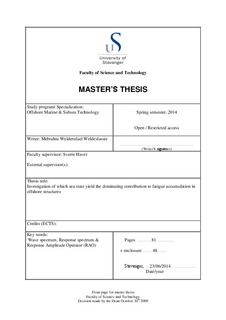| dc.description.abstract | Majority of the fatigue damage on offshore structures is generally assumed to be caused
by relatively frequently occurring moderate sea states, i.e. sea states with significant wave
height in the range of 4m - 8m.On the contrary, Økland [17] claims that the dominating
fatigue damage is caused due to higher sever sea states. These two claims in regard to
the major cause of fatigue damage are opposite to each other, therefore, this thesis aims
to investigate the inter relationship between fatigue damage verses sea state severity. To
perform this study, the thesis has identified the Kvitebjør Statoil jacket platform, in which
3-hour duration wave records are available from 1957 to 2013. These short term waves
are assumed as a stationary Gaussian process in which the sea surface elevation process
is completely described by Pierson-Moskowitz wave spectrum.
In this thesis, the analysis is performed using the spectral-based fatigue assessment
method, which is frequency domain analysis and attempts to account for the random
nature of sea states in a rational manner. The analysis is performed by developing unidirectional
transfer function or Best fit RAO, which is generated from 21 Gaussian sea
surface processes and their corresponding linear nature response processes using the Fast
Fourier Transform method (FFT). Response spectrum for a given sea state is generated
using the Best fit RAO and furthermore standard deviation and number of response cycles
of this response process are determined assuming as a narrow band response process. The
standard deviation is used to determine the scaling parameter of the Rayleigh-distribution,
which represents the distribution of stress ranges for short term. The Rayleigh distribution
and the number of response cycles of the process are combined to calculate the number of
cycles for a constant stress range in a given stress block. The number of cycles to failure
corresponding to the stress range in the given stress block are determined from "T" S-N
curve. The effect of the accumulated fatigue damage on the structure is observed by analyzing
the S-N curve with double and single slope. Finally, the linear damage calculation
by "Miner-Palmgren" summation is used to evaluate the accumulated fatigue damage.
Furthermore, the Best fit RAO is assumed to deviate at four different frequency ranges
and the fatigue damage for each deviated RAO is calculated.
The fatigue analysis results have asserted the first claim that fatigue damage in the
structure is observed to be caused due to the moderate sea states. 60% to 65% of the
accumulated fatigue damage is induced in the structure by the moderate sea states. This is
because; the moderate sea states are more than the higher sea states and have relatively
higher stress ranges than the lower sea states. On the other hand, when straight S-N
curve with slope m = 3 is used, the accumulated fatigue damage are observed to be
overestimated, particularly due to the lower sea states, i.e. sea states with significant
wave height 2m to 6m. | nb_NO |
